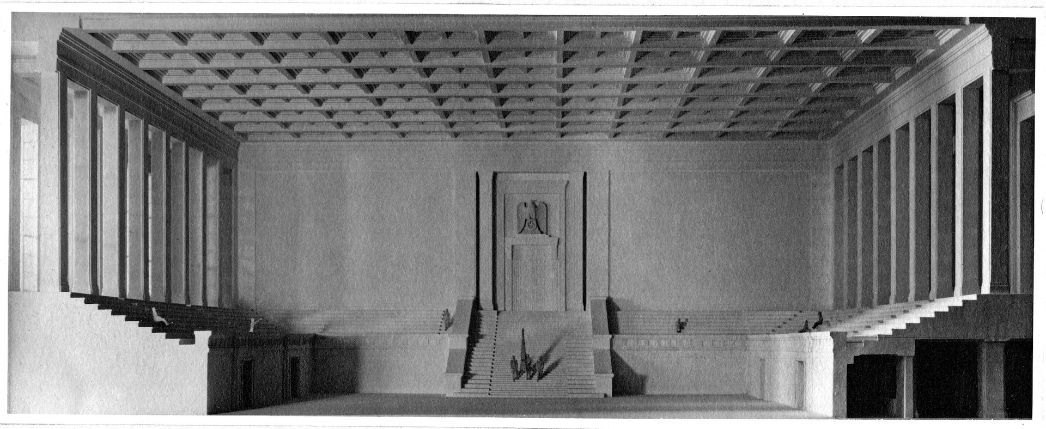
For the National Socialists' prestige project in Weimar, the Gauforum, the northern part of Jakobvorstadt, a total of 139 houses, had to be demolished and the small river Asbach diverted. Such Gauforums, in which the central administrations of an NSDAP Gau were to be combined, were planned in all Gau capitals in Germany, but were only largely realised in Weimar. On 1 May 1937, Rudolf Hess laid the foundation stone of the "Hall of the People's Community" and renamed the square "Adolf Hitler's Square". The carefully staged mass event was attended by 40,000 people. The massive complex clearly shows the NSDAP's claim to leadership; the town houses of the city of Weimar were supposed to look small next to it. Hitler personally added the "Halle der Volksgemeinschaft" to the design with standing room for 20,000 people and a bell tower, which was to be the tallest building in Weimar. Fritz Sauckel celebrated his 45th birthday in it in 1939. By 1943, all the buildings had been completed with the exception of the hall, and prisoners from Buchenwald concentration camp were used in the construction work. After the completion of the Gau Forum, Fritz Sauckel's Reich Governor's Office was planned to move from the State Museum to the southern wing of the Gau Forum, the "Reich Governor's Office and Gau Administration". An oversized study was planned for Fritz Sauckel on the first floor of the building, which was additionally emphasised by a balcony and the entrance portal. The plans for the structural remodelling of Weimar also included the immediate surroundings of the Gauforum. The new street, provisionally named "X Straße", today's Ferdinand-Freiligrath-Straße, was laid out in a nationalist homeland defence style. The flats that were built also served as a replacement for the approximately 1,650 residents of Jakobsvorstadt who were affected by the demolition of the neighbourhood. The character of the street is particularly evident at house no. 21, the Siechenbräu Inn, which has existed since August 1939. The street view consists of columns modelled on the Romanesque style, adorned with old German style decorations on the column capitals. The Gauforum remained empty until the end of the war, and on 1 May 1945 the square was renamed Karl-Marx-Platz. Although the shell of the unfinished hall was completed after the war, it was not utilised until 1967 when storeys were added. In 1976, the hall was given a concrete louvre façade that is barely visible today. Since November 2005, the former "Halle der Volksgemeinschaft" has been home to the "Weimar Atrium" shopping centre. The Thuringian State Administration Office is housed in the now listed buildings of the Gauforum. The tower building (Jorge-Semprún-Platz 2) houses a permanent exhibition on the history of the site, while the Museum of Forced Labour under National Socialism, sponsored by the Buchenwald and Mittelbau-Dora Memorials Foundation, will open in the south wing of the former Gauforum in 2024.
